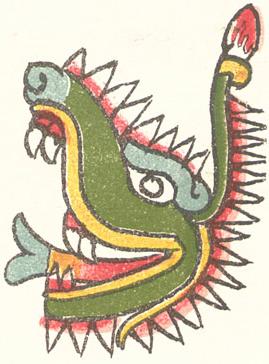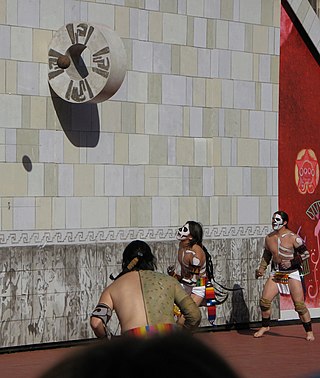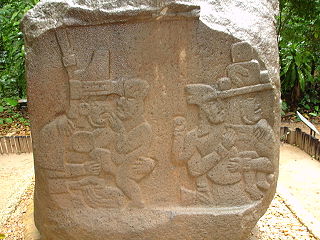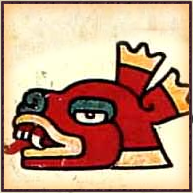Related Research Articles
Mayan or Maya mythology is part of Mesoamerican mythology and comprises all of the Maya tales in which personified forces of nature, deities, and the heroes interacting with these play the main roles. The legends of the era have to be reconstructed from iconography. Other parts of Mayan oral tradition are not considered here.

Qʼuqʼumatz was a god of wind and rain of the Postclassic Kʼicheʼ Maya. It was the Feathered Serpent that according to the Popol Vuh created the world and humanity, together with the god Tepeu. It carried the sun across the sky and down into the underworld and acted as a mediator between the various powers in the Maya cosmos. It is considered to be the equivalent of the Aztec god Quetzalcoatl and of Kukulkan, of the Yucatec Maya.

Cipactli was the first day of the Aztec divinatory count of 13 X 20 days and Cipactonal "Sign of Cipactli" was considered to have been the first diviner. In Aztec cosmology, the crocodile symbolized the earth floating in the primeval waters. According to one Aztec tradition, Teocipactli "Divine Crocodile" was the name of a survivor of the flood who rescued himself in a canoe and again repopulated the earth. In the Mixtec Vienna Codex, Crocodile is a day associated with dynastic beginnings.
Tepeu is a word of the Kʼicheʼ Maya language meaning "sovereign". The title is associated with the god Qʼuqʼumatz of the Kʼicheʼ-Maya, one of the creation gods of the Popol Vuh; his whole name translating as "Sovereign Plumed Serpent". The title has also been used by numerous Kʼicheʼ rulers such as Tepepul.

Xibalba, roughly translated as "place of fright", is the name of the underworld in Maya mythology, ruled by the Maya death gods and their helpers. In 16th-century Verapaz, the entrance to Xibalba was traditionally held to be a cave in the vicinity of Cobán, Guatemala. Cave systems in nearby Belize have also been referred to as the entrance to Xibalba. In some Maya areas, the Milky Way is viewed as the road to Xibalba.

Popol Vuh is a text recounting the mythology and history of the Kʼicheʼ people of Guatemala, one of the Maya peoples who also inhabit the Mexican states of Chiapas, Campeche, Yucatan and Quintana Roo, as well as areas of Belize, Honduras and El Salvador.
Xmucane and Xpiacoc, alternatively Xumucane and Ixpiyacoc, are the names of the divine grandparents of Maya mythology of the Kʼicheʼ people and the daykeepers of the Popol Vuh. They are considered to be the oldest of all the gods of the Kʼicheʼ pantheon and are identified by a number of names throughout the text, reflecting their multiple roles throughout the Maya creation myth. They are usually mentioned together, although Xmucane seems to be alone during most of the interactions with the Maya Hero Twins, when she is referred to as simply "grandmother".

The Mesoamerican ballgame was a sport with ritual associations played since at least 1650 BC by the pre-Colombian people of Ancient Mesoamerica. The sport had different versions in different places during the millennia, and a modernized version of the game, ulama, is still played by the indigenous populations in some places.
Kʼicheʼ are Indigenous peoples of the Americas and are one of the Maya peoples. The eponymous Kʼicheʼ language is a Mesoamerican language in the Mayan language family. The highland Kʼicheʼ states in the pre-Columbian era are associated with the ancient Maya civilization, and reached the peak of their power and influence during the Mayan Postclassic period.

The Maya Hero Twins are the central figures of a narrative included within the colonial Kʼicheʼ document called Popol Vuh, and constituting the oldest Maya myth to have been preserved in its entirety. Called Hunahpu and Xbalanque in the Kʼicheʼ language, the Twins have also been identified in the art of the Classic Mayas. The twins are often portrayed as complementary forces.
Tollan, Tolan, or Tolán is a name used for the capital cities of two empires of Pre-Columbian Mesoamerica; first for Teotihuacan, and later for the Toltec capital, Tula, both in Mexico. The name has also been applied to the Postclassic Mexican settlement Cholula.
Tzolkʼin is the name bestowed by Mayanists on the 260-day Mesoamerican calendar originated by the Maya civilization of pre-Columbian Mesoamerica.
Xquic is a mythological figure known from the 16th century Kʼicheʼ manuscript Popol Vuh. She was the daughter of one of the lords of Xibalba, called Cuchumaquic, Xibalba being the Maya underworld. Noted particularly for being the mother of the Maya Hero Twins, Hunahpu and Xbalanque, she is sometimes considered to be the Maya goddess associated with the waning moon. However, there is no evidence for this in the Popol Vuh text itself.
Mesoamerican creation myths are the collection of creation myths attributed to, or documented for, the various cultures and civilizations of pre-Columbian Mesoamerica and Mesoamerican literature.
The traditional Maya or Mayan religion of the extant Maya peoples of Guatemala, Belize, western Honduras, and the Tabasco, Chiapas, Quintana Roo, Campeche and Yucatán states of Mexico is part of the wider frame of Mesoamerican religion. As is the case with many other contemporary Mesoamerican religions, it results from centuries of symbiosis with Roman Catholicism. When its pre-Hispanic antecedents are taken into account, however, traditional Maya religion has already existed for more than two and a half millennia as a recognizably distinct phenomenon. Before the advent of Christianity, it was spread over many indigenous kingdoms, all with their own local traditions. Today, it coexists and interacts with pan-Mayan syncretism, the 're-invention of tradition' by the Pan-Maya movement, and Christianity in its various denominations.
Vucub-Caquix is the name of a bird demon defeated by the Hero Twins of a Kʼicheʼ-Maya myth preserved in an 18th-century document, entitled ʼPopol Vuhʼ. The episode of the demon's defeat was already known in the Late Preclassic Period, before the year 200 AD. He was also the father of Zipacna, an underworld demon deity, and Cabrakan, the Earthquake God.

The Feathered Serpent is a prominent supernatural entity or deity, found in many Mesoamerican religions. It is still called Quetzalcoatl among the Aztecs, Kukulkan among the Yucatec Maya, and Q'uq'umatz and Tohil among the K'iche' Maya.

Dogs have occupied a powerful place in Mesoamerican folklore and myth since at least the Classic Period right through to modern times. A common belief across the Mesoamerican region is that a dog carries the newly deceased across a body of water in the afterlife. Dogs appear in underworld scenes painted on Maya pottery dating to the Classic Period and even earlier than this, in the Preclassic, the people of Chupícuaro buried dogs with the dead. In the great Classic Period metropolis of Teotihuacan, 14 human bodies were deposited in a cave, most of them children, together with the bodies of three dogs to guide them on their path to the underworld.
The Maya death gods known by a variety of names, are two basic types of death gods who are respectively represented by the 16th-century Yucatec deities Hunhau and Uacmitun Ahau mentioned by Spanish Bishop Landa. Hunhau is the lord of the Underworld. Iconographically, Hunhau and Uacmitun Ahau correspond to the Gods A and A' . In recent narratives, particularly in the oral tradition of the Lacandon people, there is only one death god, who acts as the antipode of the Upper God in the creation of the world and of the human body and soul. This death god inhabits an Underworld that is also the world of the dead. As a ruler over the world of the dead, the principal death god corresponds to the Aztec deity Mictlāntēcutli. The Popol Vuh has two leading death gods, but these two are really one: Both are called "Death," but while one is known as "One Death," the other is called "Seven Death." They were vanquished by the Hero Twins.
Mesoamerican cosmovision or cosmology is the collection of worldviews shared by the Indigenous pre-Columbian societies of Mesoamerica. The cosmovision of these societies was reflected in the ways in which they were organized, such as in their built environment and social hierarchies, as well as in their epistemologies and ontologies, including an understanding of their place within the cosmos or universe. Elements of Mesoamerican cosmovision are reflected in pre-Columbian textual sources, such as the Popol Vuh and the Cuauhtinchan maps, the archeological record, as well as in the contemporary beliefs, values, and practices of Indigenous people, such as the Maya, Nahua, and Purépecha, as well as their descendants. It has been argued that the Day of the Dead ceremony exists as a legacy of Mesoamerican cosmovision.
References
- Horcasitas, Fernando (1988). "An analysis of the deluge myth in Mesoamerica". In Alan Dundes (ed.). The Flood Myth. Berkeley: University of California Press. pp. 183–220. ISBN 0-520-05973-5. OCLC 15629162.
- Markman, Roberta H.; Peter T. Markman (1992). The Flayed God: the Mesoamerican Mythological Tradition; Sacred Texts and Images from pre-Columbian Mexico and Central America. San Francisco: Harper. ISBN 0-06-250528-9. OCLC 25507756.
- Dennis Tedlock, ed. (1985). Popol Vuh: The Definitive Edition of the Mayan Book of the Dawn of Life and the Glories of Gods and Kings. Translated by Dennis Tedlock. New York: Simon & Schuster. ISBN 0-671-45241-X. OCLC 11467786.